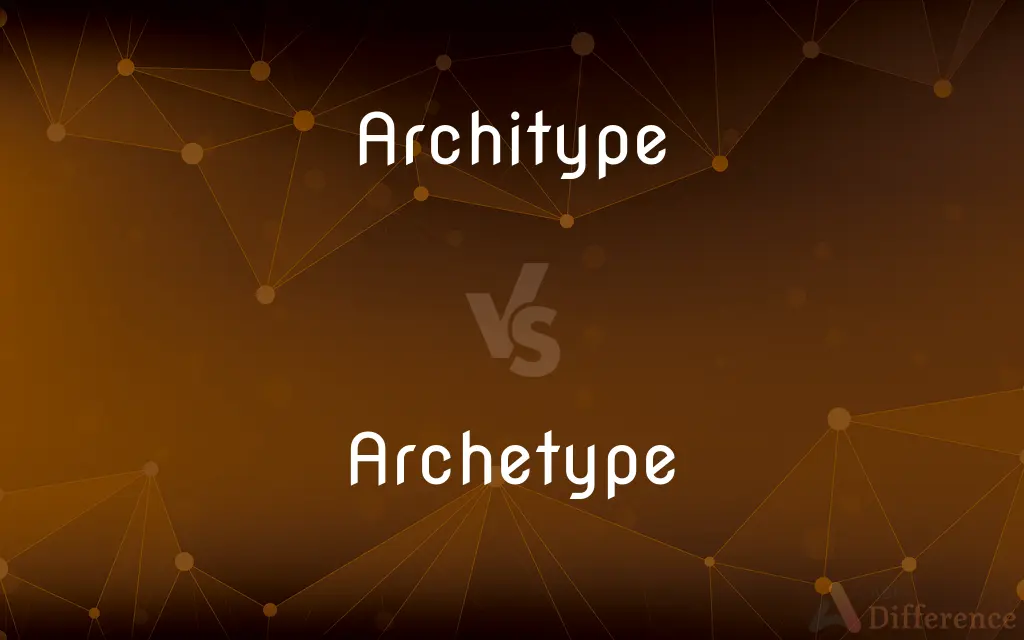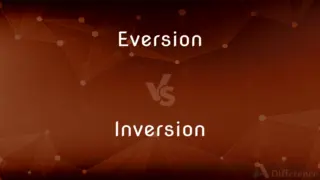Architype vs. Archetype — What's the Difference?
By Fiza Rafique & Maham Liaqat — Updated on February 26, 2024
Archetype refers to a universally recognized symbol or character, while architype, often a misspelling of archetype, has no distinct meaning in established usage.

Difference Between Architype and Archetype
Table of Contents
ADVERTISEMENT
Key Differences
Archetype is a concept widely used in psychology, literature, and art, referring to an original model or universally recognized symbol that recurs across cultures and literature. It represents typical examples of characters or themes, such as the hero, the mentor, or the quest, serving as foundational elements in storytelling and psychological analysis. Architype, on the other hand, is not a standard term in English and is often encountered as a misspelling of archetype. The confusion might arise from the similar spelling, but only archetype has recognized definitions and applications.
Particularly in Jungian theory, archetypes are innate, universal prototypes for ideas and may manifest in behavior, symbols, and myths across cultures. This concept underscores the collective unconscious and shared human experiences. There is no equivalent psychological concept for architype, reinforcing the importance of distinguishing between the correct usage of archetype and the misspelling.
Archetypes serve as foundational elements that help structure narratives and character development. Writers and artists draw upon these archetypes to create relatable and compelling stories and artworks that resonate with universal human experiences. The term architype does not apply in these creative domains, highlighting the centrality of archetypes in cultural and artistic expressions.
The misunderstanding between architype and archetype underscores the importance of accuracy in language and terminology, especially in academic and professional contexts. Recognizing archetype's role in various disciplines helps maintain clarity and fosters a deeper understanding of human culture and psychology.
The distinction also emphasizes the role of education and careful editing in preventing the spread of incorrect terms like architype, ensuring that discussions remain meaningful and grounded in established concepts.
ADVERTISEMENT
Comparison Chart
Definition
A universally recognized symbol or character
Often a misspelling of archetype with no distinct meaning
Usage in Psychology
Central to Jungian theory, represents universal prototypes
No usage or relevance
Role in Literature
Foundational elements for narratives and character development
No role or application
Cultural Significance
Recurs across cultures, embodying shared human experiences
Lacks cultural significance and recognition
Importance in Art
Influences themes and motifs in art
Not applicable
Compare with Definitions
Architype
No established definitions or examples due to its status as a misspelling.
Archetype
In Jungian psychology, an inherited pattern of thought or symbolic imagery.
The mother figure is a powerful archetype in dreams.
Architype
Does not convey a specific concept or idea.
Manuscripts mistakenly using architype require editing.
Archetype
Recurring symbol or motif in literature or art.
The trickster is an archetype found in many folk tales.
Architype
Not applicable, as it is often a misspelling of archetype.
Searching for the meaning of architype leads to corrections towards archetype.
Archetype
A typical example of a certain person or thing.
He was the archetype of a successful businessman.
Architype
Incorrectly used when archetype is intended.
Architype in essays often results from spelling errors.
Archetype
A universally recognized symbol or theme.
The hero's journey is a classic archetype in mythology.
Architype
Absence in recognized dictionaries or academic texts.
Architype is not found in scholarly literature, unlike archetype.
Archetype
A prototype upon which others are copied.
The original model served as the archetype for future designs.
Architype
Misspelling of archetype
Archetype
The concept of an archetype (; from Greek: ἄρχω, árkhō, 'to begin' + τῠ́πος, túpos, 'sort, type') appears in areas relating to behavior, historical psychology, and literary analysis. An archetype can be: a statement, pattern of behavior, prototype, "first" form, or a main model that other statements, patterns of behavior, and objects copy, emulate, or "merge" into.
Archetype
A very typical example of a certain person or thing
He was the archetype of the old-style football club chairman
Archetype
A recurrent symbol or motif in literature, art, or mythology
Mythological archetypes of good and evil
Archetype
The original pattern or model of a work; or the model from which a thing is made or formed.
The House of Commons, the archetype of all the representative assemblies which now meet.
Types and shadows of that glorious archetype that was to come into the world.
Common Curiosities
Is architype a real word?
Architype is often a misspelling of archetype and does not have a recognized meaning or usage in English.
Can an archetype appear in different cultures?
Yes, archetypes can appear in various cultures, embodying shared human experiences and universal themes.
What role do archetypes play in literature?
Archetypes serve as foundational elements in literature, guiding narrative structure and character development.
How does understanding archetypes enhance storytelling?
Understanding archetypes can enhance storytelling by tapping into universal themes and symbols that resonate with a broad audience.
Are there specific examples of archetypes in mythology?
Yes, many mythologies feature archetypes such as the hero, the mentor, the trickster, and the flood myth.
What is the significance of Jungian archetypes in modern psychology?
Jungian archetypes offer insights into the collective unconscious, helping to explain shared human behaviors and symbols.
How are archetypes used in psychology?
In psychology, particularly Jungian theory, archetypes are seen as universal, innate prototypes that influence human behavior and symbolic understanding.
Can an archetype change over time?
While the core essence of archetypes remains, their expressions can evolve with cultural and societal changes.
Can anyone create a new archetype?
New archetypes can emerge, but they must gain universal recognition and embody fundamental human experiences to be considered true archetypes.
How can one identify an archetype in a story or artwork?
Identifying an archetype involves recognizing recurring symbols, themes, or character types that reflect universal experiences.
What is an archetype?
An archetype is a universally recognized symbol, theme, or character that recurs across cultures and literature.
Why is it important to distinguish between archetype and architype?
Distinguishing between the two ensures clarity and accuracy in communication, especially in academic and professional contexts where precision in terminology is crucial.
Is the concept of archetype applicable only to literature?
No, the concept of archetype is applicable in various fields, including psychology, art, and cultural studies.
Does the incorrect use of "architype" impact its meaning in discussions?
Using "architype" incorrectly can lead to confusion and misinterpretation, highlighting the need for accurate terminology.
How do archetypes differ from stereotypes?
Archetypes represent universal, symbolic patterns, whereas stereotypes are oversimplified and fixed representations of groups or individuals.
Share Your Discovery

Previous Comparison
Eversion vs. Inversion
Next Comparison
Nullipara vs. NulliparousAuthor Spotlight
Written by
Fiza RafiqueFiza Rafique is a skilled content writer at AskDifference.com, where she meticulously refines and enhances written pieces. Drawing from her vast editorial expertise, Fiza ensures clarity, accuracy, and precision in every article. Passionate about language, she continually seeks to elevate the quality of content for readers worldwide.
Co-written by
Maham Liaqat















































